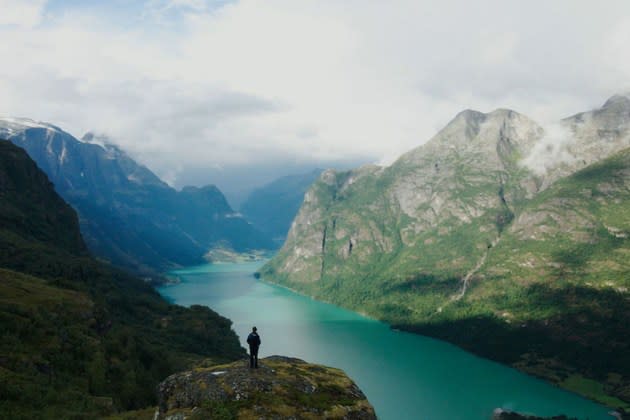‘Songs of Earth’ Review: Delicate Norwegian Oscar Submission Meditates on Mortality and Nature
- Oops!Something went wrong.Please try again later.

Phrases like “Tone poem” and “meditation” are normally used by critics to describe works of art that are small and delicate.
Margareth Olin’s new documentary Songs of Earth, Norway’s selection for best international feature at next year’s Academy Awards, is surely a tone poem and equally surely a meditation on all manner of things, from our relationship with nature to the parent-child bond. The film, which boasts Liv Ullmann and Wim Wenders among its executive producers, is also surely a delicate film, one that frequently feels like it benefits more from being experienced than analyzed or interrogated.
More from The Hollywood Reporter
Yet Songs of Earth is not a small movie. It’s a documentary that should be seen on the biggest screen at your disposal — whatever showcases its epic cinematography to its best advantage. Don’t sell Songs of Earth short, mind you, as an exclusively visual experience. Its sound design and score are every bit as immersive, and that may hold the actual key to best experiencing Olin’s film. Not everybody, or most people even, will get to experience Songs of Earth in a festival setting. But once the documentary makes its way to PBS or Netflix or whatever streamer acquires it, the more you’re able to shut off external stimuli, the more you’ll be able to let Olin’s film wash over you and the less you’ll be inclined to let your mind wander.
We are insignificant, but we are hugely significant. We are minuscule, but we are vast. We are alone, but we contain multitudes. Those thoughts, only some stolen from Walt Whitman, were what went through my mind most frequently during the 90-minute, one-year-plus journey of Songs of Earth, which has the simplest possible plot: Olin returns to the Oldedalen valley in western Norway. Her goal is to spend some time with her 84-year-old father (and her mother, but less focally), walking in his footsteps and trying to understand him. It’s an exercise that he tells her will require a full year, which ever-so-conveniently gives Olin the structure for her documentary (though after going through four seasons, there’s also an extended epilogue, which felt like a structural cheat when I dwelled on it, so mostly I didn’t).
In a literal sense, Olin learns about her father’s life; the tragedies that connected his family to the land; the astonishing, and astonishingly metaphorical, surgery that marked his youth (“When I was born, my feet pointed in the wrong direction,” says the man who spends the entire documentary hiking forward as his daughter is leading him on a project to look backward); her parents’ 55-year marriage; and their expectations for death and mourning. There are stories of deadly avalanches and multiple weddings.
Generally, though, little in Songs of Earth is that literal. Olin and her father speak in poems and whatever the Norwegian equivalent of a zen koan is. Everything gives the impression of being wisdom passed down through generations, mostly recited as voiceover as the camera soars over fjords and frozen lakes and tree-lined hills, across glaciers that laugh at the idea that 400 years of history is more than a blip. But, not surprisingly, it’s a documentary that’s aware of the changes to the climate, the changes to the landscapes, the idea that history and mortality could apply to a parent and to nature — all with very few shots that include anything “manufactured” or “man-made” imposing itself on the terrain.
That separation of human from nature is disingenuous, of course, because Songs of Earth is a modern technical marvel attributable to cinematographer Lars Erlend Tubaas Øymo, as well as multiple drone photographers and a group of credited wildlife photographers. That’s before you get into the sounds of whispering wind, gurgling bodies of water and the unnerving and yet fully natural popping and cracking of various ice formations, masterminded by sound designer Tormod Ringnes and melded in seamless harmony with Rebekka Karijord’s score.
As Olin’s father says of their own aging, “The outside may be fading, but we’re still healthy on the inside.” Viewers are left to hope that the Earth has a comparably healthy core, however much the glaciers are receding and however pervasive the sense that whatever animals we see — soaring birds of prey, lumbering reindeer, pollinating bees — aren’t as plentiful as they should be. There’s hardly a word spoken in the documentary or an image — Olin’s father’s face welcomes the tightest of close-ups, revealing crevasses and cragginess to match the most topographically dynamic of fjords — that doesn’t have a double meaning.
Now, when everything has a double meaning and the double meanings relate to the relationship between people and nature, there is going to be some thematic repetition. The same is true of the photography, as breathtaking as it consistently is. The soaring drone shots over fjords never quite become bjoring, but there are stretches where Songs of Earth shows a lot of beautiful things that are beautiful in very similar ways and have been shot to accentuate the similarities to either soothing or sleep-inducing effect (depending on the other distractions at your disposal).
Or perhaps the film is trying to give a sense of how all this wonder and wisdom could become normalized if your experience of the landscape developed over a lifetime rather than 90 minutes. Disconnect and enjoy the quiet, if repetitive, profundity.
Best of The Hollywood Reporter
Martin Scorsese’s 10 Best Movies Ranked, Including 'Killers of the Flower Moon'
13 Times Hollywood Predicted the Scary (or Not So Scary) Future of AI

